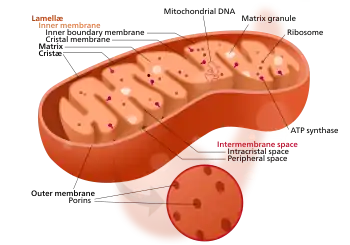Mitochondrial ribosome
The mitochondrial ribosome, or mitoribosome, is a protein complex that is active in mitochondria and functions as a riboprotein for translating mitochondrial mRNAs encoded in mtDNA. Mitoribosomes, like cytoplasmic ribosomes, consist of two subunits — large (mtLSU) and small (mt-SSU).[1] However, the ratio of rRNA/protein is different from cytoplasmic ribosomes. Mitoribosomes consist of several specific proteins and less rRNAs.[1]

Function
Mitochondria contain around 1000 proteins in yeast and 1500 proteins in humans. However, only 8 and 13 proteins are encoded in mitochondrial DNA in yeast and humans respectively. Most mitochondrial proteins are synthesized via cytoplasmic ribosomes.[2] Proteins that are key components in the electron transport chain are translated in mitochondria.[3][4]
Structure
Mammalian mitoribosomes have small 28S and large 39S subunits, together forming a 55S mitoribosome.[5][6] Plant mitoribosomes have small 33S and large 50S subunits, together forming a 78S mitoribosome.[5][6]
Animal mitoribosomes only have two rRNAs, 12S (SSU) and 16S (LSU), both highly minimizeed compared to their larger homologues.[5] Most eukaryotoes use 5S mitoribosomal RNA, animals, fungi, alveolates and euglenozoans being the exceptions.[7] A variety of methods have evolved to fill in the gap left by a missing 5S, with animals co-opting a Mt-tRNA (Val in vertebrates).[5][8]
Genes
The mitochondrial ribosomal protein nomenclature generally follows that of bacteria, with extra numbers used for mitochondrion-specific proteins. (For more information on the nomenclature, see Ribosomal protein § Table of ribosomal proteins.)
- MRPS1, MRPS2, MRPS3, MRPS4, MRPS5, MRPS6, MRPS7, MRPS8, MRPS9, MRPS10, MRPS11, MRPS12, MRPS13, MRPS14, MRPS15, MRPS16, MRPS17, MRPS18, MRPS19, MRPS20, MRPS21, MRPS22, MRPS23, MRPS24, MRPS25, MRPS26, MRPS27, MRPS28, MRPS29, MRPS30, MRPS31, MRPS32, MRPS33, MRPS34, MRPS35
- MRPL1, MRPL2, MRPL3, MRPL4, MRPL5, MRPL6, MRPL7, MRPL8, MRPL9, MRPL10, MRPL11, MRPL12, MRPL13, MRPL14, MRPL15, MRPL16, MRPL17, MRPL18, MRPL19, MRPL20, MRPL21, MRPL22, MRPL23, MRPL24, MRPL25, MRPL26, MRPL27, MRPL28, MRPL29, MRPL30, MRPL31, MRPL32, MRPL33, MRPL34, MRPL35, MRPL36, MRPL37, MRPL38, MRPL39, MRPL40, MRPL41, MRPL42
- rRNA: MT-RNR1, MT-RNR2, MT-TV (mitochondrial)
References
- Alexey Amunts; Alan Brown; Jaan Toots; Sjors H. W. Scheres; V. Ramakrishnan (2015). "Ribosome. The structure of the human mitochondrial ribosome". Science. 348 (6230): 95–98. doi:10.1126/science.aaa1193. PMC 4501431. PMID 25838379.
- Wenz, Lena-Sophie; Opaliński, Łukasz; Wiedemann, Nils; Becker, Thomas (2015). "Cooperation of protein machineries in mitochondrial protein sorting". Biochimica et Biophysica Acta (BBA) - Molecular Cell Research. 1853 (5): 1119–1129. doi:10.1016/j.bbamcr.2015.01.012. ISSN 0167-4889. PMID 25633533.
- Johnston, Iain G.; Williams, Ben P. (2016). "Evolutionary Inference across Eukaryotes Identifies Specific Pressures Favoring Mitochondrial Gene Retention". Cell Systems. 2 (2): 101–111. doi:10.1016/j.cels.2016.01.013. ISSN 2405-4712. PMID 27135164.
- Hamers, Laurel (2016). "Why do our cell's power plants have their own DNA?". Science. doi:10.1126/science.aaf4083. ISSN 0036-8075.
- Basil J. Greber; Philipp Bieri; Marc Leibundgut; Alexander Leitner; Ruedi Aebersold; Daniel Boehringer; Nenad Ban (2015). "Ribosome. The complete structure of the 55S mammalian mitochondrial ribosome". Science. 348 (6232): 303–308. doi:10.1126/science.aaa3872. hdl:20.500.11850/100390. PMID 25837512. S2CID 206634178.
- Spremulli, L. L. (2016-01-01), "The Protein Biosynthetic Machinery of Mitochondria", in Bradshaw, Ralph A.; Stahl, Philip D. (eds.), Encyclopedia of Cell Biology, Waltham: Academic Press, pp. 545–554, doi:10.1016/b978-0-12-394447-4.10066-5, ISBN 978-0-12-394796-3, retrieved 2020-11-17
- Valach, M; Burger, G; Gray, MW; Lang, BF (Dec 2014). "Widespread occurrence of organelle genome-encoded 5S rRNAs including permuted molecules". Nucleic Acids Res. 42 (22): 13764–13777. doi:10.1093/nar/gku1266. PMC 4267664. PMID 25429974.
- Brown, A; Amunts, A; Bai, XC; Sugimoto, Y; Edwards, PC; Murshudov, G; Scheres, SH; Ramakrishnan, V (Nov 2014). "Structure of the large ribosomal subunit from human mitochondria". Science. 346 (6210): 718–722. doi:10.1126/science.1258026. PMC 4246062. PMID 25278503.
Further reading
- Greber, BJ; Ban, N (2 June 2016). "Structure and Function of the Mitochondrial Ribosome". Annual review of biochemistry. 85: 103–32. doi:10.1146/annurev-biochem-060815-014343. PMID 27023846.